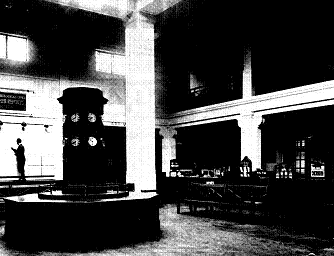
Oh, Those Magnificent Airmen in Their Very Frail Flying Machines
The open fields of what later became Croydon Airport were first used as an aerodrome for defence by those pioneering amateurs of air combat, the Royal Flying Corps, in 1917.
But at the end of the War, they upped chocks and vacated the site.
In 1920, the aerodrome came back into use, but this time for commercial aviation.
The new set-up took over the RFC buildings surrounding an old farmhouse on one side of Plough Lane. Next door was an aircraft assembly works and a railway-style level crossing connected the two sites.
In 1920 the airport even briefly had an airship tower - London was hosting a conference of the Empire's political leaders and a demonstration flight of a new airship was laid on to entertain them between talk of rebellious natives and the tea crop. But the tower was soon removed, as it had been built on private land.
Pilots from France at that time navigated to Croydon by following railway lines : from Ashford along the line through Kent, or north along the Brighton line.
The changes of landing in the right place were improved when the Government persuaded the railway companies to paint the names of salient railway stations along the route, such as Tonbridge and Banstead, on the roofs.
This created, another problem though. After a couple of collisions, pilots and management decided it was time to dictate whether planes should keep to the left or right of the tracks. The right side was agreed and pilots slept easier at night.

Emergency landing places along the route were also established - one was at Penshurst. Many small airline companies were set up, one of the first being Air Transport and Travel, though few were successful at a time when flying was too expensive for the most families.
In 1924 several aviation companies were amalgamated to form Imperial Airways, with a Government subsidy. (This was meant to be tapered down, but grew over the decades instead, though the French and Dutch gave higher subsidies to their aviation industries.)
Imperial Airways was known for the comfort of its aircraft (for the day) and for safety - though by today's standard, their flights were positively dangerous.
Air travel was the preserve of first class passengers up to the time of The Depression, and after that, the airlines went in search of a wider market.
The aeroplanes were piston-engined biplanes, with the pilot in an open cockpit - most were British and built by Vickers. De Haviland and Handley Page.
Other airfields came into being at this time, such as Grove Park and Eltham in SE London.
In 1928 Croydon Airport was enlarged. The centre of Plough Lane was removed, uniting the whole site. The wartime buildings, with their later additions, were swept away - to be replaced by the splendid terminal building, with its main hall accommodating the offices of the airlines. The Aerodrome Hotel was built next door, by the new Purley Way - one could go on its roof for 1pence to watch the planes overhead.
There were plans for a railway connection in 1929, but The Depression intervened. Plans were revived in 1934 but came to nothing.
See the second part of this article to follow next week.